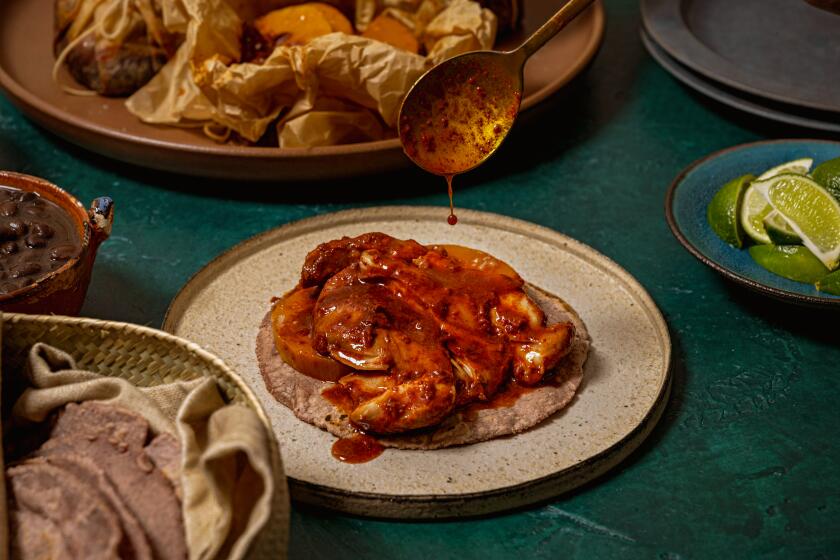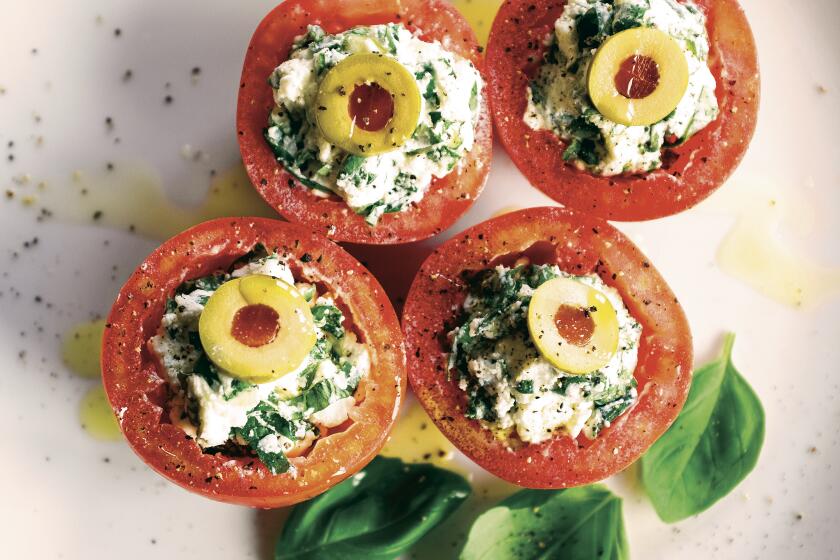Shrimp Satay

- Share via
Walk through Bangkok on a cool, quiet morning and you’ll see puffs of smoke rising from each side of the street. The air will be filled with the scents of searing chile and cilantro, and the sounds of a city stirring to life. Every day before sunrise, the same ritual takes place: Thailand’s satay vendors set up their carts, thread thin slices of meat onto bamboo skewers and grill them over a vigorously fanned charcoal fire.
The seductive aroma--of smoke and meat and intriguing spices--is the perfume of a Thai morning.
Unlike the lackluster versions so common in American Thai restaurants, where they seem to be part of the standard appetizer platter served alongside a pile of mee krob, real Thai satays are intricately spiced and endlessly inventive. They can be made with almost anything that can be cooked over an open fire--shrimp, chicken, pork or even tiny whole fish and frogs.
Furthermore, because they can be prepared in advance to be finished quickly just before serving, they also fit well into an American summer menu, served either as appetizers or the main course.
Throughout central and southern Thailand the satay scene is repeated. The vendors are everywhere, in big cities and in small provincial towns. They are at street corners, obscure lanes, busy traffic-jammed intersections, open-air markets and even modern supermarkets. Sold a handful at a time with a bag of cucumber relish and peanut sauce, satays are a perfect snack to eat on the run.
Even though they are everywhere in Thailand today, satays are actually a fairly modern addition to the national cuisine. They became the rage during the reign of King Chulalongkorn, who ruled from 1868 to 1910. Known as a connoisseur, Chulalongkorn established his royal court as an epicurean center. He was the first Thai monarch to travel abroad, and among the many places he visited were Singapore and Penang, a southern border town in Malaysia where he encountered tiny skewers of grilled food dipped in savory sauces and called satays.
Shish kebab of one kind or other is characteristic of Muslim cuisines, so satay may ultimately be a Middle Eastern import. The Muslim traders who converted the Javanese to Islam exerted a strong culinary influence on the islanders. The flavorings of satay are Southeast Asian, though.
Thai satay recipes are versatile. They are constantly being altered to the tastes of different regions of the country, and even of local neighborhoods.
One vendor in Bangkok’s Chinatown marinates long pieces of thinly sliced pork with a touch of cumin, red chile powder and loads of minced garlic, turmeric powder and coconut cream. When grilled, it is slightly crispy and a bit chewy, like soft jerky.
Another vendor in Phet Buri (Petchaburi), a province approximately 2 1/2 hours by car from Bangkok, uses more turmeric in the marinade, staining the pork into glowing golden color. She also adds a chunk of pork fat at the tip of the flattened pork strip. When grilled, the fat is the best-tasting part of the satay, having turned crisp from the grill. Her peanut sauce is sweeter than most, loaded with more coconut cream and palm sugar, to please the local addiction to sweet food.
But there are certain things that are constant. For one thing, Thais prefer charcoal to gas for cooking. The more intense heat sears the food, browning the outside layer. Once the flames die down, the ash-covered red embers provide a constant heat that allows food to cook evenly.
Although charcoal briquettes are readily available, search out lump hardwood charcoal. It is closest to what Asians use to fuel their grills. Though briquettes are convenient, they contain additives that can impart a chemical taste.
Also, they cut the meat into pieces small enough to cook quickly over the high heat. Long, thin slices are the preferred form. They can be neatly and securely threaded onto skewers.
These sticks can be made of metal, wood, split bamboo or even aromatic branches such as lemongrass stalks. To prevent them from burning, soak the skewers in water for 30 minutes, then dry them thoroughly before using. If you choose metal skewers, look for the thin flat ones, which will prevent the meat from slipping.
To me, the most exquisite of all satay recipes is the one by M.L. Neong, who grew up in one of the lesser palaces after King Chulalongkorn’s reign. One day I was fortunate to be invited to lunch with her by a mutual friend. Spry, rather petite and regal-looking, she lived in a small wooden Thai-style home with her longtime companion and lady-in-waiting.
Neoung’s recipe for satay originally came from one of the aristocratic ladies of the court, who learned it from a Javanese. It became one of the favorite dishes of a royal princess who bestowed it with a special name--satay leuh, meaning “famous satay,” for its alluring and irresistible taste.
The secret for this famous satay recipe is in its marinade and the way the meat is laced through the skewer. Neoung said that unlike the common folk’s satay, which to her was crude and simple, this recipe cleverly altered the Javanese recipe by reducing the amount of spices in the marinade to retain the flavor of the meat.
Paper-thin slices of pork--prohibited to Muslims but preferred by the Thais--are marinated with freshly dry-roasted spices. They are laced on a thin whittled palm frond and pushed together so tightly that they resemble one solid chunk of meat. The satay is served piping hot, fresh off the grill, with sweet-syrupy sauce.
A bite of the moist succulent satay, juicy and scented with traces of ancient spices, sent me on a journey with Neoung, back to her childhood, to the fairy tale life of the royal court, where food was considered not merely human sustenance, but a creative expression of civilized people.
Su-Mei Yu is the author of “Asian Grilling” (William Morrow, 2002).
Marinade
Place the peppercorns in a small skillet and dry-roast over medium-high heat, sliding the skillet back and forth over the burner to prevent burning, until the spice exudes a pleasant aroma, about 1 minute. Remove from the heat and transfer to a bowl to cool. Repeat with the coriander seeds. Grind the peppercorns and coriander seeds together and set aside.
Combine the garlic, peppercorns and coriander seeds, ginger, cayenne, salt, basil and soy sauce in a bowl and mix well. Add the oil and mix again to combine. Set aside. (Stored in a glass jar with a tight-fitting lid, the marinade will keep for a week in the refrigerator.)
Satay
Soak 16 to 18 bamboo skewers in water for 30 minutes, then pat dry.
Meanwhile, add the shrimp to the marinade and mix well to coat. Cover and refrigerate for at least 20 minutes, but no longer than 1 hour.
Mound the charcoal in one side of the grill, leaving the other side empty. Heat the grill.
Remove the shrimp from the refrigerator. Thread a shrimp from the tail through the body to the head onto a bamboo skewer, adding 3 to 4 shrimp to each skewer. Repeat with the remaining shrimp.
Spray the shrimp generously with vegetable oil. Lay the skewers with the shrimp portion on the grill over medium-high heat, arranging them very close to one another. (The uncovered portion of the skewers should not be over the coals.) Grill, turning frequently to prevent burning and brushing with the reserved marinade, until the shrimp are pink and firm, 3 to 4 minutes. Transfer to a platter and serve.
Get our Cooking newsletter
Get a taste of Los Angeles — and the world — with recipes and kitchen tricks from the L.A. Times’ Cooking newsletter.
You may occasionally receive promotional content from the Los Angeles Times.















